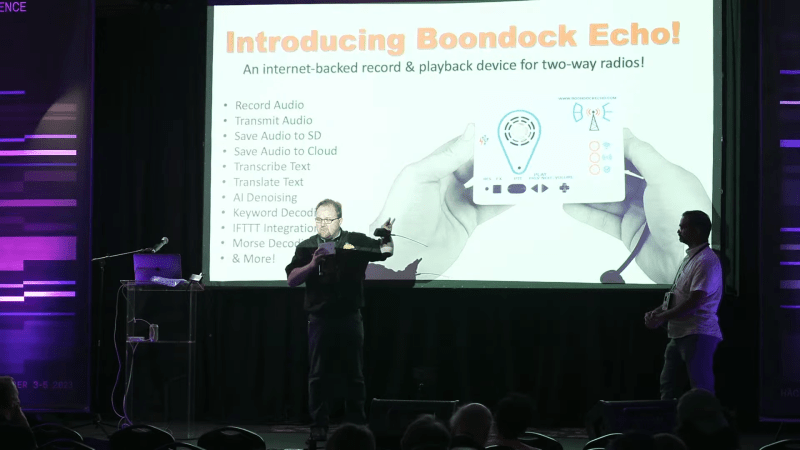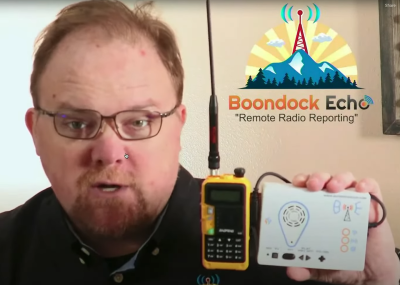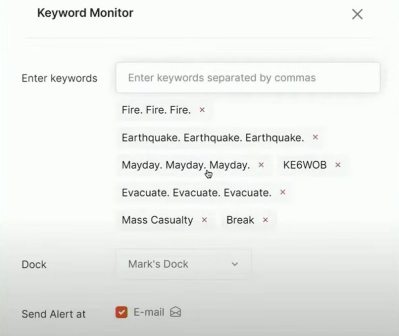2023 Hackaday Supercon: One Year of Progress for Project Boondock Echo

Do you remember the fourth-place winner in the 2022 Hackaday Prize? If it’s slipped your mind, that’s okay—it was Boondock Echo. It was a radio project that aimed to make it easy to record and playback conversations from two-way radio communications. The project was entered via Hackaday.io, the judges dug it, and it was one of the top projects of that year’s competition.
The project was the brainchild of Mark Hughes and Kaushlesh Chandel. At the 2023 Hackaday Supercon, Mark and Kaushlesh (KC) came back to tell us all about the project, and how far it had come one year after its success in the 2022 Hackaday Prize.
Breaker, Breaker
The talk begins with a simple video explainer of the Boondock Echo project. Basically, it points out the simple problem with two-way radio communications. If you’re not sitting in front of the receiver at the right time, you’re going to miss the message someone’s trying to send you. Unlike cellular communications, Skype calls, or email, there’s no log of missed calls or messages waiting for you. If you weren’t listening, you’re out of luck.

Mark was inspired to create a device to solve these problems by his father’s experience as an emergency responder with FEMA. Often, his father would tell stories about problems with radios and missed transmissions, and Mark had always wondered if something could be done.
Boondock Echo is the device that hopes to change all that. It’s a device designed for recording and playback of two-way radio communications. The hardware is based around the ESP32, which is able to capture analog audio from a radio, digitize it, and submit it to the Boondock Echo online service. This also enables more advanced features—the system can transcribe audio to text, and even do keyword monitoring on the results and email you any important relevant messages.

Rather amazingly, Hackaday actually helped spawn this project. Mark had an idea of what Boondock Echo should do, but he didn’t feel like he had the full set of technical skills to implement it. Then, Mark met KC via a Hackaday Hackchat, and the two started a partnership to develop the project further. Eventually, they won fourth place in the 2022 Hackaday Prize, which netted them a tasty $10,000 which they could use to develop the project further. They then brought in Mark’s friend Jesse on the hardware side, and things really got rolling.
The hope was to start producing and delivering Boondock Echo devices. Of course, nobody is immune to production hell, and it was no different for this team. KC dives into the story of how the device relied on the ESP32-A1S module. When they went to make more, this turned out to be problematic. They found some of the purchased modules worked and some didn’t. Stripping the RF shields off the pre-baked modules, they found that while they all included audio codec chips marked “8388,” some modules had a different layout and functioned differently. And these were parts with FCC IDs, identical part numbers, and everything! This turned into a huge mess that derailed the project for some time. The project had to be retooled to work with the ESP32-based AI Thinker Audio Kit, to which they added a custom “sidekick” board to handle interfacing with the desired radio hardware.

Mark notes that there were some organizational lessons learned through this difficult journey. He talks about the value of planning and budgets when it comes to any attempt to escape the “Valley of Death” as a nascent startup. Mark also explains how Boondock Echo came to seek investors to grow further when he realized they didn’t have the resources to make it on their own.
“You don’t go out asking for $10,000 from family and friends, you go out and you ask for a heck of a lot more than that from professional investors,” explains Mark. “It’s a lot easier to come up with $100,000 than $10,000, because the venture capitalists don’t play in the $10,000 price range.” Of course, he notes that this comes with a tradeoff—investors want a stake in the company in exchange for cold, hard cash. Moving to this mode of operation involved creating a company and then dividing up shares for all the relevant stakeholders—a unique challenge of its own. Mark and KC explain how they handled the growing pains and grew their team from there.

The rest of the talk covers the product itself, and we get a demo of what it can do. KC and Mark show us how the Boondock Echo units capture audio, record it, and submit it to the cloud. From there, we get to see how things like AI transcription, keyword triggers, and notifications work, and there’s even a fun live demo. Beyond that, Mark explains how you can order the hardware via CrowdSupply, and sign up with the Boondock Echo cloud service.
It’s not just neat to see a cool project, it’s neat to see something like this grow from an idea into a fully-fledged business. Even better, it grew out of the Hackaday community itself, and has flourished from there. It’s a wonderful testament to what hackers can achieve with a good idea and the will to pursue it.